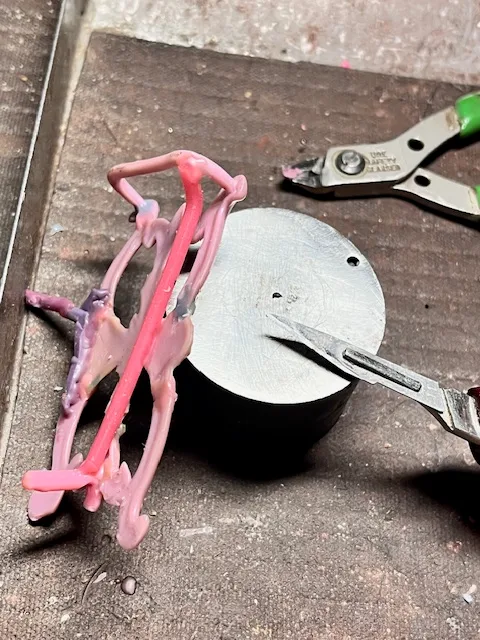Preparing wax forms before casting presents many obstacles. The following instances might sway you from proceeding further.
This one wax in particular shows how the wax overshadows the sides of the pendant.
The only solution is to add an extra line of wax to accommodate the circle of the claw setting.
The basic loop for the chain is just too ordinary to be used. By adding an extra wire of wax, it now becomes a loop blending into the pendant. You can easily adjust the new loop to accommodate your necklace chain.
This "Queen of Diamonds" designed pendant was created with the assistance of my CAD designer. With this, I can place the loop on either end, and it is still usable.
When my wife and I took a "Princess" cruise, I was anxious to create a pendant using the "Princess" logo. The CAD designer was a great help in creating the pattern WITH ME.
This basic bezel ring can only accommodate one size of gemstones. But the simplicity makes the ring attractive. The sprue wax injection site is sufficient for casting.
My off-site caster attached a sprue of the correct width, and no need for any extra modifications.
This ring that I altered had to be adjusted to make the flow of hot metal during casting satisfactory. I always circumvent any further problems by adding a thicker sprue. The shank of the ring was really too thin for any flowing of any metal.
This 'collection of circles' is named "Azure" as this will fit inside the hollow ring and will also fit against the finger.
This horse's ring was a two-piece construction. The only problem was that the ring needed much piercing before casting.
The horseshoe was easier set with stones, then it can be soldered to the main section of the ring.
If there is a definite build-up of wax residue on the tip of the heating pen, how can it be cleaned?
This ring that I altered had to be adjusted to make the flow of hot metal during casting satisfactory. I always circumvent any further problems by adding a thicker sprue. The shank of the ring was really too thin for any flowing of any metal.
This photo explains how this wax ring will eventually look. Every fine detail took much planning, even thinking why I should put a small Blue Sapphire on the side? I decided on a two-colour casting.
This 3-piece ring had much planning between my CAD designer & I, as it culminated in many days of designing.
All it takes is a few moments at a high temperature and let the wax just burn itself off!
This heart-shaped pendant needed 10 stones to be set, which can be quite easy. On the reverse, or top side, I 'inked' where the stones will be placed and melted some extra wax to those delicate spots.
I increased the waxsprue width to accommodate the extra wax for the metal casting.
This is the final step in modifying this unusual pendant.
The wax sprue MUST NEVER BE PLACED WHERE THE POINT OF THE PENDANT IS TO BE DESIGNED. This 'point' must always be a point and not need any re-shaping.
WHAT IS YOUR CHOSEN NUMBER? You will notice where each of the sprues is attached; these sprues must not interfere with the 'number' design.
I have been doing these wax modifications and observing where the sprues should be located. Watching other jewellers and casters can be a 'great teacher'.
WHAT IS YOUR CHOSEN NUMBER? You will notice where each of the sprues is attached; these sprues must not interfere with the 'number' design.











.jpg)
.jpg)
.jpg)
.jpg)
.jpg)

.jpg)

.jpg)

.jpg)
.jpg)
.jpg)
.jpg)
.jpg)
.jpg)
.jpg)
.jpg)
.jpg)
.jpg)
.jpg)
.jpg)


.jpg)


.jpg)




.jpg)

.jpg)
.jpg)
.jpg)
.jpg)
.jpg)
.jpg)
.jpg)

.jpg)


.jpg)

.jpg)

.jpg)
.jpg)

.jpg)